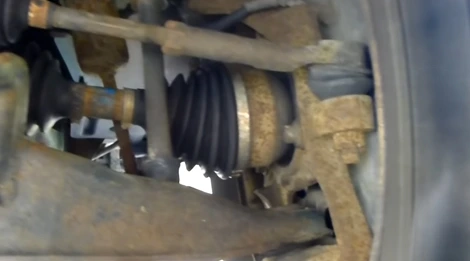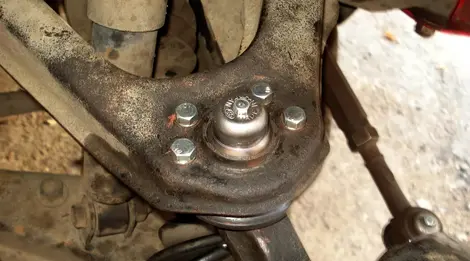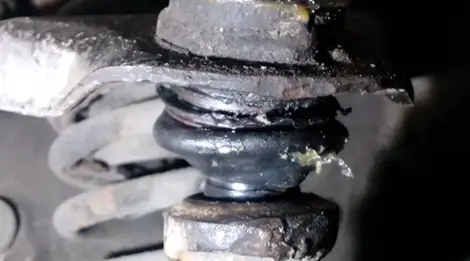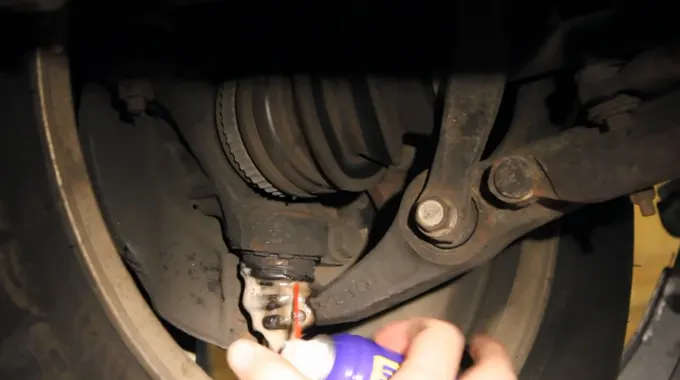Last Updated on May 24, 2023
If you’re hearing a squealing noise when you turn your car, it might be the ball joints. Ball joints connect the steering knuckle to the control arm and allow the wheels to move up and down as well as rotate. Over time, they can wear out and start making noise.
In this article, we’ll show you how to fix ball joint squeak in your car without having to take it to a mechanic.
What are Ball Joints, And What Do They Do?
Ball joints are a type of joint that connects the steering knuckle to the control arm. They allow the wheels to move up and down as well as rotate. It’s essential to keep them in good condition, as they can wear out over time and start making noise.
How do I Know If My Ball Joints Need to Be Replaced?
If you’re hearing a squealing noise when you turn your car, it might be the ball joints. However, there are other possible causes of this noise, so it’s best to have a mechanic take a look at it.
Some Helpful Tips: How to Fix Ball Joint Squeak?

There are a few things you can try to fix a ball joint squeak in your car. These include:
1. Lubricate the Ball Joints:
Particularly the lower ball joints are prone to premature wear and tear if not properly lubricated. This can result in a squeaking or rubbing noise when turning, which can be quite concerning.
To fix the issue, start by safely lifting the vehicle off the ground and removing the wheel and rubber boot to gain access to the ball joint. Inspect the joint for any signs of damage or wear, and note the amount of grease present. If the joint appears to be dry or lacking in grease, this is likely the cause of the issue.
Next, remove the ball joint from the control arm and clean it thoroughly to remove any debris or buildup that may be present. Apply a generous amount of high-quality grease to the joint, spreading it evenly across the surface.
Be sure to use a grease gun to properly lubricate the joint, as this will help spread the grease evenly between the ball and socket. You can use a silicone spray or WD-40.
Once the joint has been properly lubricated, reattach it to the control arm and tighten all bolts and nuts to the manufacturer’s specifications. It’s important to note that over-tightening can cause damage to the joint, so be sure to use a torque wrench to achieve the correct amount of tightness.
After the ball joint has been reinstalled, test drive the vehicle to ensure that the squeaking or rubbing noise has been resolved. If the issue persists, replacing the ball joint entirely is necessary.
2. Tighten the Bolts:
Over time, the bolts can loosen, which can cause the ball joint to car squeak. Tighten them up using a wrench. While you’re at it, check the other bolt-on your car and make sure they’re all tightened up.
3. Use Oil:
Another way to reduce the noise is to use oil. Pour a small amount of oil onto a rag and then apply it to the ball joint. Oil can help reduce the friction between the parts.
4. Change Screw:
If the noise comes from the screw that holds the ball joint in place, you can try changing it. Use a wrench to loosen the screw and replace it with a new one. Make sure you use a torque wrench to tighten it correctly.
5. Replace the Ball Joints:
If none of these methods work, you might need to replace the ball joints. This can be a difficult task, so it’s best to leave it to a mechanic. It’s also an expensive repair, so you might want to consider whether it’s worth it.
These are some of the methods you can use to fix a ball joint squeak in your car. Most of them are simple and can be done without taking the car to a mechanic. However, if the noise persists, it’s best to have a professional take a look at it.
Why is Proper Greasing of Ball Joints Crucial for Your Vehicle’s Safety?
Ball joints are a critical component of a vehicle’s suspension system, responsible for connecting the control arm to the steering knuckle. However, many factories fail to spread grease effectively between the ball and socket, leading to potential problems that could result in catastrophic failure.
When installed upside down, the ball may lock up in the socket due to grease dropping out, causing the castle nut to shear off and rotate in the ball joint hole. This can bore out the hole over time, necessitating the lower arm replacement if left unfixed.
By understanding the importance of proper ball joint maintenance and greasing techniques, you can ensure your vehicle’s safety and longevity on the road.
Is It Worth Avoiding?

Here are some awful things that could happen if you ignore a ball joint squeak:
The Ball Joint Could Break:
This is the most serious consequence of ignoring a ball joint squeak. If the ball joint breaks, it can cause the car to lose control and crash.
Damage to Other Parts of the Car
If you’re hearing a noise coming from the ball joints, it’s because they’re wearing out. Continuing to drive with worn-out ball joints can damage other car parts, such as the suspension and steering system.
Long-term Costs Could Be Higher
If you ignore a ball joint squeak and it damages other parts of the car, you’ll end up paying more to have those parts fixed. It’s always best to address the problem as soon as you notice it.
Risk of Getting Hurt
If the ball joint breaks or you lose control of the car, you could injure yourself. It’s always best to address any problems with your vehicle as soon as possible.
Could Void Your Warranty
During the time that your car is still under warranty, you should bring it to the mechanic for a ball joint replacement. If you do not, you may lose your warranty. It’s always best to check with the manufacturer before having any work done on the car.
So, if you’re hearing a noise coming from your ball joints, don’t ignore it.
Signs That You Need To Replace Your Ball Joints

Here are some signs that you might need to replace your ball joints:
- Squealing noise when turning your car
- The ball joints are worn out
- You can’t move the steering wheel freely
- There’s excessive play in the joint
- The ball joint is visibly damaged or rusty
If you’re experiencing any of these signs, it’s time to replace your ball joints. This can be a difficult task, so it’s best to leave it to a professional. It’s also an expensive repair, so you might want to consider whether it’s worth it.
Tips for Keeping Your Ball Joints in Good Condition
In order to keep your ball joints in good condition, here are some tips:
Keep Your Car Well-Maintained
Make sure you keep your car well-maintained and in good condition. This includes regularly changing the oil, checking the fluids, and keeping the tires inflated properly.
Have the Ball Joints Inspected Regularly

If you’re experiencing any of the signs that your ball joints need replacing, have them inspected by a mechanic. It’s better to be safe than sorry.
Use a Torque Wrench to Tighten Bolts
When you’re tightening bolts, make sure you use a torque wrench to make sure they’re tightened correctly. Over-tightening bolts can damage the ball joints.
Tighten the Bolts Regularly
Make sure you tighten the bolts regularly, especially if you’re experiencing any of the signs that your ball joint might need replacing. This will help keep the ball joint in good condition.
Avoid Driving On Rough Roads
If you can, avoid driving on rough roads. The more abuse your car takes, the quicker the ball joints will wear out.
FAQs
Can Ball Joints Be Repaired?
Yes, ball joints can be repaired. However, if they’re severely damaged, they might need to be replaced.
Can I Do The Repair Work Myself?
It’s possible to do the repair work yourself, but it can be not easy. If you’re not confident in your ability to do the work, it’s best to leave it to a professional.
Is it Worth Replacing the Ball Joints?
That depends on how severe the damage is and how much it will cost to replace them. It might be more economical to replace the ball joints than to repair them in some cases.
Can You Drive With A Squeaky Ball Joint?
You can drive with a squeaky ball joint, but it’s not advisable. The noise might signify that the ball joint is worn out and needs to be replaced.
Conclusion
Replacing your car’s ball joints can be an expensive task, but it’s important to do so before they cause further damage to the car. In this article, we’ve outlined some tips for keeping your ball joints in good condition and avoiding a costly repair job. We hope you find these tips helpful and that they help you keep your car in good shape. Thanks for reading.
